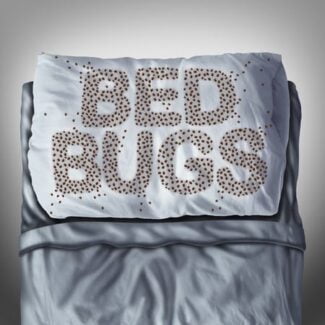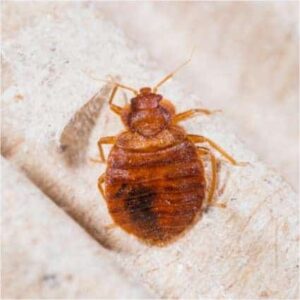You might have heard that you can kill bed bugs by suffocating them in a plastic bag. So, it’s tempting to think that you might be able to kill them by sealing them in a bag—either using vacuum sealing or just tying them in for long enough for them to die.
It’s impossible to suffocate bed bugs with vacuum sealing. The only way they’ll die by sealing them in a plastic bag is if you leave them in there for long enough that they starve.
Bed bugs do die reasonably quickly without oxygen. The problem is that it’s practically impossible to create a true vacuum with no air in it, unless you have access to industrial or scientific equipment.
How Long Can Bed Bugs Live Without Air?
We were contented with killing bed bugs with common pesticides like DDT, which practically wiped them out in the developed world. Infestation rates were so low that we thought we might even wipe them out as vaccination did to the smallpox virus.
Nature has a habit of finding a way. Bed bugs developed a resistance to DDT and many other common insecticides, and since the late ‘90s, they’ve enjoyed a worldwide renaissance. Rates have skyrocketed in the U.S., Europe, and Australia, where they were previously almost entirely eradicated.
Scientists are looking for better ways to kill bed bugs that they can’t develop a resistance to. One of these promising avenues is vacuum treatment.
Can Bed Bugs Survive in Vacuum Sealed Bags?
Studies have been done into how well bed bugs survive in an oxygen-depleted atmosphere.
The Journal of Economic Entomology found that “all life stages of bed bugs were found to be susceptible to ULO (ultra-low oxygen) and vacuum treatments…” So, they were successful, but there’s an important reason why you can’t do this at home.
The scientists used bed bug colonies in laboratory settings to test their idea. They sealed them in half-gallon jars, and gradually flushed out the regular air inside.
They replaced it with pure nitrogen gas. Each jar contained a different level of oxygen: 0.1%, 0.5%, 1%, 2% and 3%. There were also a number of jars that had different levels of oxygen and different temperatures. They were trying to find the optimal way to kill bed bugs in the shortest time possible.

They found that every single bed bug life stage was susceptible to ULO treatment. The lower the oxygen level, the longer the treatment lasted, and the higher the temperature, the quicker they died.
After 8 hours at 0.1% oxygen, at 86 Fahrenheit, 99.1% of the bed bugs died. That’s comparable to the best rates you’ll find with common insecticides and other solutions, like heat treatments.
You will have noticed that they used a defined, medical term: ultra-low oxygen. This refers to any atmosphere—air—which contains less than 1% oxygen. Even at just 3%, 96% of the insects died after 48 hours (at the same temperature).
For reference, the normal level of oxygen in the air is 21%. So, it’s true: bed bugs can suffocate just like any other animal.
Two more studies had similar outcomes: one in the Journal of Medical Entomology, and one for the International Conference on Urban Pests.
This looks like a promising new way to kill bed bugs. There’s only one problem is that you can’t replicate these conditions at home.
Why Won’t It Work at Home?
If you happen to have industrial or scientific equipment at home, you’re in luck. You can kill as many bed bugs as you like.
There’s no chance you can achieve the same conditions. That’s because of the biggest problem with home vacuum sealing: it’s not 100% effective. Let’s say you’re planning on throwing your clothes into a vacuum-sealed bag to kill bed bugs.
At the very least, this can isolate the bed bugs, but it won’t do much more. Here’s why:
- Clothes and fabric are loose and don’t compress well. They, therefore, hold onto air quite easily, even if it looks from the outside like all the air is gone.
- Depending on the quality of your bag, the air seal may not be perfect condition. It might, therefore, allow a small amount of air in overtime, or immediately when you remove the vacuum hose.
- Vacuum packing doesn’t just remove oxygen. It removes all air. The level of oxygen isn’t going down, the amount If there’s even a little amount left, there’s still plenty of oxygen for the bed bugs to breathe.
Not only that, but bed bugs are so small that they hardly need any air. Seal yourself in a plastic bag that’s just a little bigger than you, and you’ll run out of air quickly.
Seal yourself in a bag that’s 50,000 times bigger than you—like you’re doing with a bed bug—and you could survive for a very long time, even if almost all of the air was taken out (assuming you could survive without food and water as long as a bed bug can, up to a year).
The same, of course, applies when you seal bed bugs in a ziplock bag or a regular plastic bag. There’s more than enough air in there for them to survive, and they will until they run out of food.
They don’t even die from a lack of water. That being said, it’s still an effective tactic to isolate bed bugs from the rest of your home while you deep-clean your room.
Does Putting Clothes in Bags Kill Bed Bugs?
So, let’s say you’ve started your clear-out after you discovered an infestation. Because of the way bed bugs spread—they love anywhere dark, where they can hide from the light and from you—they love clothing, especially if you leave it on the floor.
But they can hide in your wardrobe and live in your clothes there, too, if it’s close enough to your bed. That’s why one of your first steps to dealing with an infestation is to kill bed bugs on clothes.
You might be tempted to dump all your clothes in bags. This could serve two purposes: keeping the bed bugs isolated, and, maybe starving them of food and oxygen. We’ve already found out that bed bugs are completely immune to being sealed inside something.
So, on that count, sealing your clothes is useless. That being said, it will keep your clothes (and the bed bugs inside them) isolated from the rest of your home.
As a method of control, though, it’s a poor choice.
Alternative Way to Kill Bed Bugs
If you have bed bugs in clothes, the best thing to do by far is to wash and dry them. Like we said above, bed bugs are exceptionally vulnerable to high temperatures. For bigger items, pest controllers use steam machines.

For anything that’s machine-washable, though, you can simply wash it to achieve the same effect. You can also dry clothes in a washer-dryer if you have one, which is even more sure to kill any bugs and eggs in your clothes.
The best thing about doing it this way? It takes a couple of hours. Sealing your clothes in a bag could take a year, and even then, you can’t be sure that every single bug is dead.
So, it might take a little more effort, but you’re saving yourself a year of wondering whether your technique actually works. Just make sure you follow these tips if you choose to launder your clothes:
- At all times, keep potentially infested clothes sealed away from any other clothes—or anything else. This will stop them from spreading.
- Be careful when you’re handling the clothes. There’s a chance that the bed bugs could fall out of the clothes. Or, their eggs might do the same.
- Pack your clothes into plastic bags inside the room that’s infested. Seal the bag before you leave. Double, in fact, triple check it to make sure that there are no holes or splits in the bag before you take it to the laundry.
- After you’ve washed the clothes, put them into a fresh, clean bag and seal that too. You’re going to have to keep them in bags until you can be sure there aren’t any more bed bugs to infest them.
Follow these four steps and you can be sure of killing the infestation.
Can Bed Bugs Get Out of Plastic Bags?
Of course, it’s not quite as simple as all that. Bed bugs are tiny. And, if you’ve never seen them, you might be surprised at how quickly they can crawl.
They’re little explorers, which is how they found you in the first place. As such, it should come as no surprise that they can easily find their way out of a regular plastic bag.
- Many grocery bags have small holes in the bottom, that you might never have noticed. These are to prevent suffocation if children or animals play with the bag. Aside from that, they often have tiny holes as a result of poor manufacture. Bed bugs will find these holes in seconds.
- Anything but a completely air-tight seal isn’t good enough. Drawstring bags, for example, leave enough of an opening at the top for bed bugs to get out. Seal the top with tape, so that nothing can get in and out.
- Bed bugs don’t have teeth in the way that we do; they can’t chew or scratch their way out of a bag. But there’s always a chance that a rodent or pet might try to get into the bag, and create holes in it. That’s especially the case if you’re storing the bags long-term, for whatever reason.
Your best option is to not store bed-bug infested clothes, or anything, in a bag for too long. Use basic plastic bags only for transporting infested items out to the trash, or to the washing machine.
A related method of killing bed bugs—one that’s becoming more and more popular now that they’re making a comeback—is simply to hoover them up.
Not only does it get rid of them, but they might find it hard to breathe, first because of the vacuum suction and then because there isn’t much air in the vacuum bag. But does it work?
Can You Kill Bed Bugs with a Vacuum Cleaner?
Vacuum cleaners offer an effective way to manage, if not completely eradicate, a bed bug infestation. Bed bugs aren’t strong enough to stop themselves from being sucked up a vacuum cleaner hose (unless they’ve found an excellent hiding place).
You can significantly reduce the number of bed bugs in any living space just through regular vacuum cleaning. Do bear in mind, though, the following advice:
- A vacuum won’t kill bed bugs, just get rid of them. There’s more than enough air in a vacuum cleaner bag for them. And the trip up the hose might leave them disoriented, but it won’t kill them.
- If you use a vacuum cleaner to manage bed bugs, be thorough. Go over every part of a carpet or mattress more than once. This helps capture more eggs, which are stuck in place.
- Use the crevice tool to vacuum in corners, and under folds.
After you use your vacuum, immediately empty it in the trash—outside. Can bed bugs survive outside? Yes, but they won’t be able to get back in.
And bed bugs can make their way out of a vacuum cleaner, either through the casing or the hose. That’s why you should always use a vacuum cleaner with a bag, rather than the bagless kind (like Dyson: great for cleaning, not for bed bugs).
Like we said above, you can’t kill bed bugs with a vacuum cleaner. They’ll stay alive inside of it, and the same rules apply: it doesn’t matter how little food or water they have, they can still live for up to a year.
They can also happily lay eggs in your vacuum cleaner, too. All things considered, then, using a vacuum is a great idea, but there are limitations you should be aware of.
Alternative Way to Kill Bed Bugs
Bed bugs are very vulnerable to high and low temperatures. Anything over 113 Fahrenheit is enough to kill any bed bug.
According to the Department of Entomology at Virginia Tech, bed bugs exposed to temperatures of more than that will die—with 100% mortality rate—over a course of 90 minutes. Increase the heat to 118 degrees, and they die in 20 minutes.
You might be able to guess where we’re going: we’re talking about steam cleaning. Steam cleaners can produce a heat of 150 degrees, which is more than enough to kill bed bugs in short order.
It would also kill any eggs in your carpet, which are, if anything, the main problem—kill all the bed bugs you want, but if you leave their eggs, they’ll be back in a couple of weeks.
Combine steam cleaning with vacuum cleaning for the best effect. Vacuum before, to pick up as many bugs as you can. Steam clean, so that you can get as many eggs as possible. Then vacuum again afterward, to pick up any debris/dead bed bugs that you can find.
What Are Plastic Bags Good For?
Whether or not they can kill bed bugs, plastic bags are still useful—especially ziplock bags and plastic bins. You can use these to keep your cleaned, bed-bug-free clothes and items away from everything else. Let’s take a look at how.
How Long Can Bed Bugs Live in a Ziplock Bag?
Ziplock bags are even smaller than vacuum-sealed bags; they can have less air in them, and it’s easy to see any bed bugs that are inside them. You might, therefore, want to isolate any bed bugs from their friends by using one.
The bad news is that airtight zipped bags don’t kill bed bugs any quicker than the other methods listed above. However, they are an excellent way to protect certain items while you’re trying to clear an infestation. Consider using them to protect:
- A set of clothes, like work clothes, that you don’t want to be infested. This stops you spreading eggs and bugs at home, and at work.
- Everyday items like laptops that you need to keep bed-bug free, but which aren’t easily laundered. Bed bugs can find their way inside electronics.
- Any personal valuables that you’d rather not have damaged, which can fit into a ziplock bag.
Bed bugs don’t have mouths, in the sense that we do. They have a sharp feeding tube, not unlike a mosquito. They lack the ability to chew or tear their way out of a bag—or into one.
Can Bed Bugs Get into Plastic Bins?
The only way a bed bug can get inside a large, properly sealed plastic storage bin is if you put them in there. Plastic storage bins are a great idea if you have bed bugs.
This is not so you can kill them, but so that you can keep your non-infested or cleaned items away from anything you suspect may have bugs or eggs in it. They’re necessary for storing anything that’s been washed so that your clothing can’t be re-infested.
That being said, not all plastic bins are created equal. Any that have a lid that sits on top isn’t good enough. Bed bugs are wafer thin and can fit in the narrowest gaps. A crack as wide as a credit card will do. So, if the lid isn’t secured, there’s a chance that they can get in.
By contrast, many plastic bins have secure, fastening lids that click into place. These are perfect. If you already have plastic bins whose lids don’t snap into place, you can make them bug-proof by sealing it with tape around the outside.
Bed bugs are perfectly happy living in plastic bags, zip lock bags, and plastic bins. Even vacuum cleaners. But you can still use them to separate infested things from anything you’ve cleaned: just make sure you keep them strictly separated because they can survive for a year inside.
They’ve lived alongside us for thousands of years and survived our best efforts so far. It’s little wonder, then, that they’re still outsmarting us even now.


I have put lids on all my totes. They snap together. Is it safe to say that they will die in time?
I’m sorry but this information you’re putting out there is false. As a matter of fact bedbugs can and will die in ziplock bags. I myself am battling these devilish nightmare critters and I’m finding ways to kill them by trial and error. When I find them I put the into a ziplock bag for my rental office. Every time I do they die within a couple of days. ALSO may I add that vacuum sealed bags are becoming a lifesaver! I have tried many many different ways to kill and get rid of them and from trial and error I’m finally finding the answers. ZIPLOCK BAGS, VACUUM SEALED BAGS, HARRIS BEDBUG KILLER WORKS LIKE A CHARM AND A STEAM CLEANER! Along with bedbug mattress casings. Please don’t discourage people by putting out this false information. This is actually the only way I have found to kill these suckers.